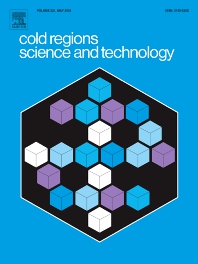Journals in Soil mechanics
Journals in Soil mechanics
Cold Regions Science and Technology
Cold Regions Science and Technology is an international journal dealing with the science and technical problems of cold environments in both the polar regions and more temperate locations. It includes fundamental aspects of cryospheric sciences which have applications for cold regions problems as well as engineering topics which relate to the cryosphere.Emphasis is given to applied science with broad coverage of the physical and mechanical aspects of ice (including glaciers and sea ice), snow and snow avalanches, ice-water systems, ice-bonded soils and permafrost.Relevant aspects of Earth science, materials science, offshore and river ice engineering are also of primary interest. These include icing of ships and structures as well as trafficability in cold environments. Technological advances for cold regions in research, development, and engineering practice are relevant to the journal. Theoretical papers must include a detailed discussion of the potential application of the theory to address cold regions problems. The journal serves a wide range of specialists, providing a medium for interdisciplinary communication and a convenient source of reference.Please see below the areas of research that the Editor in Chief and Associate Editors lead on, with support from members of the Editorial Board.Sea ice and arctic marine technology - Prof. Jukka TuhkuriSnow and snow avalanche - Dr. Nicolas Eckert & Dr. Betty SovillaFrozen soil, frozen rocks and permafrost - Prof. Jilin Qi & Prof. Mingyi ZhangRiver ice - Prof. Mark LoewenAtmospheric icing - Dr. Krzysztof Szilder- ISSN: 0165-232X

Soil & Tillage Research
Soil and Tillage Research is an ISTRO-affiliated journal that examines the physical, chemical and biological changes in the soil caused by tillage and field traffic. Manuscripts on all aspects of soil science, physics, technology, mechanization and applied engineering for a sustainable balance among productivity, environmental quality and profitability are considered. The following are examples of suitable topics within the scope of the journal of Soil and Tillage Research:The agricultural and biosystems engineering associated with tillage (including no-tillage, reduced-tillage and direct drilling), irrigation and drainage, crops and crop rotations, fertilization, rehabilitation of mine spoils and processes used to modify soils.Soil change effects on establishment and yield of crops, growth of plants and roots, structure and erosion of soil, cycling of carbon and nutrients, greenhouse gas emissions, leaching, runoff and other processes that affect environmental quality.Characteriza... or modeling of tillage and field traffic responses, soil, climate, or topographic effects, soil deformation processes, tillage tools, traction devices, energy requirements, economics, surface and subsurface water quality effects, tillage effects on weed, pest and disease control, and their interactions.- ISSN: 0167-1987

CATENA
Catena is an interdisciplinary journal of soil science and geomorphology with a focus on geoecology, landscape ecology, landscape evolution and hydrology. Original research papers, comments, and reviews linking field, laboratory, and/or modelling results, integrating different geospheres, and discussing soil and landscape processes on different spatial and temporal scales will be considered, provided they are sufficiently novel and of broad interest.Reviews are expected to critically discuss and synthesise findings and approaches on topics falling within the core aims of Catena. Short comments (no more than 2 journal pages i.e. ca. 2000 words) are considered for publication only if they bring important scientific new elements and/or corrections/improvem... on substantial aspects of previously published articles. Manuscript... that will not be considered include papers on the following topics:Research papers summarising literature results, and bibliometric analyses (meta-analyses are not included). Studies without explicit relation to landscape patterns or processes, such as:Purely geological or groundwater studies.Runoff studies that have no relation to soil or geomorphic change.Chemical laboratory experiments with no relation to ‘real’ field conditions.Microbiol... studies with no relation to soil formation or landscape processes.Geotechnic... and environmental engineering studies.Geobotanical... ecological and vegetation studies with no (or limited) relation to soil, hydrology, geomorphology or landscape evolution.Agricultur... production experiments without a solid relation to landscape.Studies on ecosystem services and land use planning.Comparisons of the performance and robustness of models and statistical methods (e.g. process-based, or machine learning) with no or only a minimal landscape-learning effect.Regionally oriented studies which cannot be applied to other landscapes (or lack novelty in approach or methodology).The Chairs of the Editors-in-Chief do not accept pre-submission enquiries to determine if a manuscript is likely to be of interest to the journal.- ISSN: 0341-8162

Engineering Geology
Engineering Geology is an international interdisciplinary journal bridging the fields of the earth sciences and engineering, particularly geological and geotechnical engineering. The focus of the journal is on geological or engineering studies that are of interest to engineering geologists, whether their initial training is in geology or civil/mining engineering. The studies published in this journal must show relevance to engineering, environmental concerns, and safety.Sample topics of interest include but are not limited to applied geomorphology and structural geology, applied geophysics and geochemistry, environmental geology and hydrogeology, land use planning, natural hazards, remote sensing techniques, soil and rock mechanics and applied geotechnical engineering.Paper types considered are original research articles, case histories, and comprehensive reviews. Case studies, in particular, should emphasize why the paper is of interest to the international readership of this journal, and/or what new or novel research or theoretical methods are being presented.The journal is intended for academic scientists, industry and applied researchers, and policy and decision makers.- ISSN: 0013-7952
